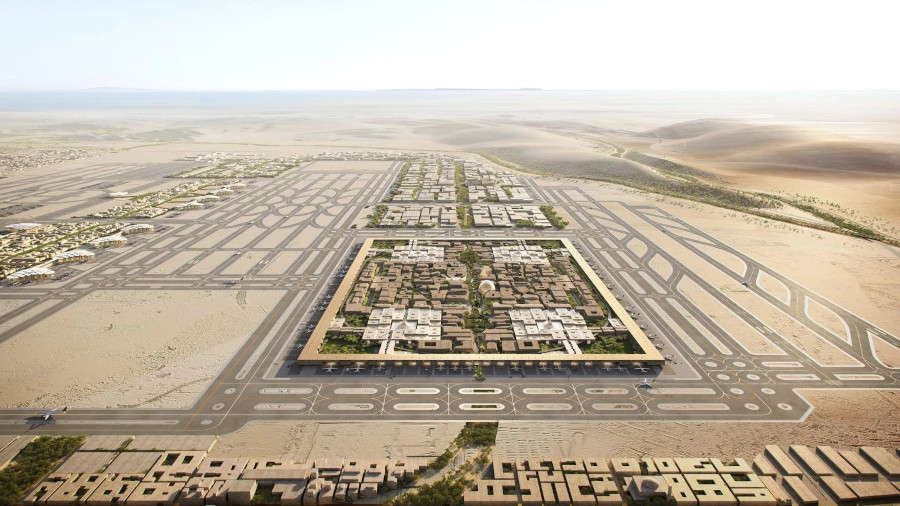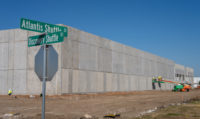Airports
Dubai Unveils $35B Plan for World's Largest Airport

When fully complete, the new Al Maktoum International Airport will accommodate 400 gates enabling the facility to handle up to 260 million passengers annually.
Rendering courtesy Dubai Media Office
Dubai has unveiled a $35-billion plan to create the largest airport in the world out of the emirate’s second largest airfield, the Al Maktoum International Airport. The massive project will enable the airport to surpass and eventually replace the existing Dubai International Airport, currently the busiest in the world for international traffic—a title it has held for a full decade.
“We are building a new project for future generations, ensuring continuous and stable development for generations to come,” said Dubai’s ruler Sheikh Mohammed bin Rashid Al Maktoum in a statement on April 28. “Dubai will be the world's airport, its port, its urban hub, and its new global center."
In addition to allowing Dubai to meet expected growth in passenger traffic for the foreseeable future, the new Al Maktoum International Airport will help Dubai fend off growing completion from Saudi Arabia.
The expanded airport—which is also known as Dubai World Central—will cover more than 27 sq miles and feature five parallel runways. The four terminals will accommodate 400 gates enabling the facility to handle up to 260 million passengers and more than 13 million tons of cargo a year.
An estimated 87 million passengers and 1.81 million tons of cargo passed through Dubai International last year. Upon completion of the first phase of Al Maktoum International Airport’s expansion in 2034, official estimate that airport will be able to handle as many as 150 million passengers per year.
All operations at the Dubai International Airport will be transferred to the expanded Al Maktoum International Airport as the project progresses. Emirates airlines, currently based at Dubai International is scheduled to relocate to Al Maktoum International Airport by 2034.
The Al Maktoum International Airport expansion will replace the Dubai International Airport.
Renderings courtesy Dubai Aviation Engineering Projects and Dubai Media Office.
Keeping Up With Demand
The project will create a dramatic change in roles for Dubai’s two main airports. Dubai International Airport, which is located less than three miles from Dubai’s city center, originally opened in 1960 and has undergone multiple expansions to include the three terminals in use today. Terminal 3 was built for $4.1 billion and opened in 2008 is the world’s largest airport terminal by floor area.
The problem for the Emirate’s leaders is that traveler demand is expected to grow substantially in the future while Dubai International Airport cannot. Further expansion of the facility is limited due to the growth in residential developments nearby and the confluence of several major highways.
The alternative is the Al Maktoum Airport. Located more than 20 miles southwest of Dubai, the airfield opened in 2010. Initially, the airfield only handled cargo flights with passenger traffic added a year later. In 2022, an estimated 877,400 passengers used the airport.
"The new airport, which will ultimately be over five times the size of Dubai International, will prepare the ground for the next 40 years of anticipated growth in Dubai’s aviation sector," said Sheikh Ahmed bin Saeed, Second Deputy Ruler of Dubai.

Read ENR's 2006 story about the construction of Dubai International Airport's $4.1B Concourse 3 project.
Dubai's Investment in Aviation Takes Shape in the Desert
The planned expansion aims to take advantage of the undeveloped areas that surround the airport. Not only will the new airport be an order of magnitude larger than Dubai International, the emirate intends to create an “airport city” around the expanded facility, officials said. The new urban center will house a million residents and be connected to Dubai via road and transit networks.
According to Dubai Aviation Engineering Projects (DAEP), the infrastructure developer for Dubai’s aviation sector, the first phase of construction for the Al Maktoum International Airport expansion will include the construction of Concourse 1 which, according to officials, will be equivalent in size and length of all three concourses currently operating at Dubai International combined.
Concourse 1 will stretch 1.7 miles in length, cover almost 19 million square feet and have 100 contact gates. A West Terminal building will be constructed in the first phase. An automated people mover system will be built with four initial stations. Two new runways will be built to accompany the existing two.
The first phase will include the construction of a ground service equipment road network, an underground baggage handling system, parking areas, multiple energy centers as well as fire safety and other support facilities.
Phase 2 of the Al Maktoum International Airport project will include the construction of a second Concourse parallel and identical to Concourse 1 featuring three new people mover station. The final phase will involve the construction of Concourses 3 and 4, an East Terminal and include the connection of the trans-UAE rail system, Etihad Rail and a planned Metro line expansion. Two additional runways will be built and the people mover system will be expanded to 14 stations on a full loop.
Air Superiority
The upgraded Al Maktoum International Airport is also critical for Dubai to remain a regional transportation and logistics hub in light of efforts by Saudi Arabia to increase airport capacity. The effort is part of the kingdom’s Saudi Vision 2030 aimed at diversifying Saudi Arabia away from its dependence on oil revenues.
The plan, introduced in 2016, calls for making Saudi Arabia a regional logistics hub in part by increasing air connectivity to 250 destinations and transporting 330 million passengers. A number of major airport expansions and new construction has since been unveiled.
In 2022 Saudi Arabia’s Crown Prince Mohammed bin Salman announced a $7.2 billion expansion plan for the King Salman International Airport in Riyadh. The expanded airport would cover 22 square miles and include six parallel runways. When completed, the airport would be able to accommodate 120 million passengers by 2030 and 185 million by 2050, according to Saudi Arabian officials.
According to Middle East Economic Digest, the UK-based Mace Group has been named the delivery partner for the project. The airport masterplan is designed by UK architecture firm Foster + Partners and US-based Jacobs handled the infrastructure design.

The King Salman International Airport expansion will accommodate 120 million passengers annually when complete.
Rendering courtesy Foster + Partners
Additionally, Saudi Arabia is planning to dramatically expand airport operations on the country’s west coast as part of the NEOM megaproject. Last September, Justin Erbacci stepped down as the the CEO of Los Angeles World Airports to assume the role of CEO for the planned $500 billion development.
NEOM’s plans call for the creation of a four-airport network, including one international airport. The first, NEOM Bay Airport opened in 2019 and began receiving international flights in 2022 with weekly round trips from Dubai.
Future plans for the airport call for a two runway facility able to handle 20 million passengers a year by 2030. Last year, Dallas-based AECOM was awarded the contract provide project management on masterplanning, design and construction services.
The future of the overall NEOM project is somewhat uncertain however. Bloomberg reported last month that the Saudi government is dramatically scaling back its plans for The Line, a linear city that is set to be the centerpiece of the NEOM megaproject. According to reports, the planned 170-km linear city with 1.5 million residents is expected to have only 2.4 km completed by 2030.







